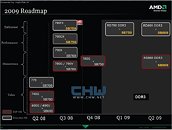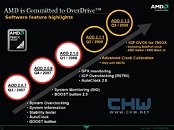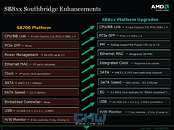Saturday, July 5th 2008

AMD Chipset Roadmap for 2009 Uncovered
As of today, AMD is close to over a year and a half behind Intel with the implementation of the DDR3 system memory standard, and it doesn't look like we are going to see a DDR3 AMD platform only until late this year or early next year. Chilian website CHW.net published slides of the roadmaps for AMD chipsets in the months to come, also published are slides refering to the details of the next generation southbridge by AMD, even though the latest entry, the SB700 is only teething and only the latest motherboards with 7-Series chipsets feature this.
The roadmap shows that the immediate entry into the market would be the AMD 790GX northbridge. Think of it as a fusion between 780G and 790X. Or better put, a 790X with an integrated graphics processor (IGP), or even better put, AMD's response to NVIDIA's flagship AM2+ chipset, the NForce 750a that supports SLI and also features an IGP. The companion southbridge, SB700 has come a tad-late into the market, we had expected 7-series chipset featured boards to come with this but it's known that a clock-generator fault was detected with early batches of the SB700 and AMD had recalled it before it could feature with premium 7-series boards, that's part of the reason why flagship 790FX boards such as ASUS M3A32-MVP Deluxe and Gigabyte GA-790FX-DQ6 featured the dated SB600 with an additional SATA controller for two or more extra SATA ports. We already find SB700 with some of the recent 780G boards.
The roadmap shows the presence of a SB750, which simply put is all the features of SB700 plus an added SATA RAID 5 mode along with the advanced clock caliberation support for Overdrive. This will feature only with the high-end 790FX and 790GX northbriges. Speaking of northbridge, a DDR3-'supportive' variant of the RD790 (AMD 790FX/GX) is slated for Q1 2009. By 'supportive', we mean that the boards this chipset features in have DDR3 or DDR3+DDR2 slots. It's important to note that memory standard compatibility is a function of the memory controller AMD processors (CPU) carry. On a AM3 board that features both DDR3 and DDR2 slots, you will be able to use both current Phenom processors and those future Phenoms with DDR3 support. The current Phenom processors will not work on boards with only the DDR3 slots since today's Phenom doesn't feature a DDR3 IMC.
An evolution of this northbridge would be the RD890 and RS880 which are slated for Q2 2009. These parts come with support for G3MX, that allows support for fully-buffered DRAM in its server/workstation variants. These northbridges are likely to be accompanied by a newer SB800 southbridge. The third slide provides insight into what edge this SB offers over the current SB700 series. The most important of them being an evolved 'A-Link'. A-Link is the chipset bus (that which connects the NB to SB) that AMD (formerly ATI) has been using since they entered the chipset business. Simply put, this is a 4-lane PCI-Express connection that offers 1000 MB/s (each direction) of bandwidth, that makes the SB a PCI-E device that connects to the PCI-E switch located in the northbridge. As times pass, with southbridges coming with as many as 14 USB 2.0 ports and 6 SATA ports, there has been an increasing need to expand this bus. Intel uses the age old Direct Media Interface in its current chipset, which apparently could be bottlenecking it even now. This can be advocated by the fact that in the D5400XS "Skulltrail", the NB connects to the SB using 4 PCI-E lanes as supplimentry connections apart from DMI. With QuickConnect however, things could change. NVIDIA uses a strong HyperTransport link as its chipset bus. With the SB800, the A-Link gets a revamp, the SB800 now connects to the system using PCI-E 2.0 x4, double the bandwidth.
AMD also plans to revamp its Overdrive system performance management software, with users and experts pointing out limits and flaws with its current model.
I will conclude my wrap on this roadmap saying that it looks impressive, lot of features that were begging to be added are in, but all that remains is that there has to be a good processor to go with all that. With newer processors on the cards, we have to hope for the best, and fear the worst (or wait for CHW to leak another set of slides so we could tell you more :-)With inputs from CHW
The roadmap shows that the immediate entry into the market would be the AMD 790GX northbridge. Think of it as a fusion between 780G and 790X. Or better put, a 790X with an integrated graphics processor (IGP), or even better put, AMD's response to NVIDIA's flagship AM2+ chipset, the NForce 750a that supports SLI and also features an IGP. The companion southbridge, SB700 has come a tad-late into the market, we had expected 7-series chipset featured boards to come with this but it's known that a clock-generator fault was detected with early batches of the SB700 and AMD had recalled it before it could feature with premium 7-series boards, that's part of the reason why flagship 790FX boards such as ASUS M3A32-MVP Deluxe and Gigabyte GA-790FX-DQ6 featured the dated SB600 with an additional SATA controller for two or more extra SATA ports. We already find SB700 with some of the recent 780G boards.
The roadmap shows the presence of a SB750, which simply put is all the features of SB700 plus an added SATA RAID 5 mode along with the advanced clock caliberation support for Overdrive. This will feature only with the high-end 790FX and 790GX northbriges. Speaking of northbridge, a DDR3-'supportive' variant of the RD790 (AMD 790FX/GX) is slated for Q1 2009. By 'supportive', we mean that the boards this chipset features in have DDR3 or DDR3+DDR2 slots. It's important to note that memory standard compatibility is a function of the memory controller AMD processors (CPU) carry. On a AM3 board that features both DDR3 and DDR2 slots, you will be able to use both current Phenom processors and those future Phenoms with DDR3 support. The current Phenom processors will not work on boards with only the DDR3 slots since today's Phenom doesn't feature a DDR3 IMC.
An evolution of this northbridge would be the RD890 and RS880 which are slated for Q2 2009. These parts come with support for G3MX, that allows support for fully-buffered DRAM in its server/workstation variants. These northbridges are likely to be accompanied by a newer SB800 southbridge. The third slide provides insight into what edge this SB offers over the current SB700 series. The most important of them being an evolved 'A-Link'. A-Link is the chipset bus (that which connects the NB to SB) that AMD (formerly ATI) has been using since they entered the chipset business. Simply put, this is a 4-lane PCI-Express connection that offers 1000 MB/s (each direction) of bandwidth, that makes the SB a PCI-E device that connects to the PCI-E switch located in the northbridge. As times pass, with southbridges coming with as many as 14 USB 2.0 ports and 6 SATA ports, there has been an increasing need to expand this bus. Intel uses the age old Direct Media Interface in its current chipset, which apparently could be bottlenecking it even now. This can be advocated by the fact that in the D5400XS "Skulltrail", the NB connects to the SB using 4 PCI-E lanes as supplimentry connections apart from DMI. With QuickConnect however, things could change. NVIDIA uses a strong HyperTransport link as its chipset bus. With the SB800, the A-Link gets a revamp, the SB800 now connects to the system using PCI-E 2.0 x4, double the bandwidth.
AMD also plans to revamp its Overdrive system performance management software, with users and experts pointing out limits and flaws with its current model.
I will conclude my wrap on this roadmap saying that it looks impressive, lot of features that were begging to be added are in, but all that remains is that there has to be a good processor to go with all that. With newer processors on the cards, we have to hope for the best, and fear the worst (or wait for CHW to leak another set of slides so we could tell you more :-)With inputs from CHW



28 Comments on AMD Chipset Roadmap for 2009 Uncovered
I will not comment on the CPU's as they are not the main subject here.
That is a very very very weak press release from AMD. Is that the extend of their "winning strategy".
With Intel just releasing their "10 year roadmap" to 10nm, my money is on Intel.
e.g.
SATA AHCI 1.1 to AHCI 1.2 - that is going to add a whoosh.
PCIe1.0 to PCIe2.0 - catch up, standard on Intel now.
Ethernet (3rd party) to Ethernet (AMD) - oh crikey!
USB 12 ports to 14 ports - thanks, but 8 is enough.
Clock (3rd party) to clock (AMD) - thank goodness the mainboard will keep AMD time
IGP overclocking - oh man, i always wanted to overclock my IGP desktop speeds. (IGP is NOT for overclockers, but for corporate and media boxes, so OC is silly)
Boost button - OMG, just like the "turbo" button from the 80's. Press it in and the machine underclocks to 8Mhz to be compatible with DOS software from 8086/286 days
The deal with DDR3 not coming to AMD until 2009 isnt anything new. We have known about that for awhile. In case any of you have forgotten, do a tpu search on it, it was posted a good while back. AMD dragged feet on DDR2 and it didnt hurt them really one bit. I like the fact that they are waiting for prices to come down.
SB600 isnt really a bust and I dont see why alot of folks think so. As I said in news posts before, it was a heralded SB from AMD as the 580 was somewhat limited. Now its not worth squat from recent reports. Im just confused on it :roll:
BT, thanks for this post, there was alot of information from the slides, but I think AMD has already put PCIe2.0 slots in their newest boards. Ill have to check but I think my boards PCIe 16x slots are 2.0.
4./ WHO, and I really mean this, WHO, is going to use 14 USB ports on their PC. Where exactly will these ports be... and for what devices. Please dont given me an crazy exceptional situation, like industrial control, but Joe Consumer, or Rocket Overclocker.
6./ The IGP chipset either has HD decoding abilities or doesnt. If it does, it will be OK without overclocking. If it doesnt, the CPU will do the work. OC the IGP is useless.
As for IGP, AMD's integrated graphics are currently the best performing ones...780G is a tad more than an IGP, it's got decent amount of juice for WoW, HD movies, etc. It is capable of really-casual gaming, why not have provision to OC it?
OK, interesting to hear about the IGP comments. So perhaps OC the IGP is an option for some people. So I accept it as valid
Agree, RAID 5 silly for consumer, but ok for enthusiast. I can see the relevance there.
But 14 USB ports! Really, where you put them to... (lots of backplates covering PCI slots?)... and what would you connect them to? I cannot in my wildest dreams think of what you can connect them to.
Let's try a list:
- Mouse
- Keyboard
- Printer
- Printer 2
- Scanner
- External HDD
- External HDD 2
- Skype phone
- VGA expander
- External soundcard
- Digital camera
- iPod
- Eprom programmer (exotic)
- Phone PBX (exotic)
So I can imagine an enthusiast possibly getting to 12. But the exotics are so rare that you dont plug them in permanently, or you are running on a network and you have a NAS and network printers and you get 4 USBs freed up.NO. There is no reason for 14 other than usbpenis marketing.
P.S.
Wrong about the car. I drive my car at over 200km/h OFTEN. That's a benefit of travelling through Germany on their (usually) fantastic autobahns. :D
16. Mobile phone connector (nr2)
17. Photo camera connector
18. USB expansion cord (3m.)
19. Your USB stick
20. Your friends (i.e. data transfer from stick to stick) USB stick
there are plenty of uses for USB ports, the only thing that keeps me not to do all them is how many ports are on PC (and USB splitter)
22.gamepad
23.Steering Wheel
24.Bluetooth Dongle
25.MP3 Player
NOBODY has e.g. 2 MP3 players, 2 digital cameras, 2 mobile phone connectors, 1 skype, steering wheel, gamepad, 2 external HDD AND 2 USB sticks, AND my original list, all connected AT THE SAME TIME.
USB is plug and play. That's the whole point. WTF!
i have about 7 perm connected to mine and have a total of 11 usb items so it could be handy,not essential of course but if its there itd be nice.
Like I said, yes, you CAN do it, but, NO, its not necessary, and if you DO, your desk is a complete mess.
Point it. Joe Consumer or Rocky Overclocker, doesnt need 14. If, the 1 in 10,000 oddball wants to plug 14 devices in all at the same time, then just as a PCI card with extra USBs. But to make a board that has 14 connectors on? Well, in my book, there are other priorities, and other things I would value more, including a mainboard 5cents cheaper.
Personally, more PCIe lanes would be more interesting, e.g. more slots at x16 or x8 or x4.
That is the major consideration for me... I never use all the USB ports on the back but the headers have been a problem for me in the past and could be a limiting factor for future upgrades. I just built a HTPC recently and I'm pretty sure the IR reciever/VFD used a USB header as well. So if I wanted to add that function to my normal computer I might be s.o.l. Likewise if I wanted to switch the cardreader on the HTPC to one that had more than one USB.
One other thing, I wouldn't compare this to Intel's announcement. Reading the article posted I didn't see a roadmap to 10nm. They said they see a clear path, which should suggest that they settled on & proved the viability of a process that will let them pass the 32nm point but the article doesn't seem to talk about specifics in that respect at all.
Dont you just HATE it when the USB port falls over due to too much current draw... like the ipod or an external HDD taking *just* a little too much current that it fails.